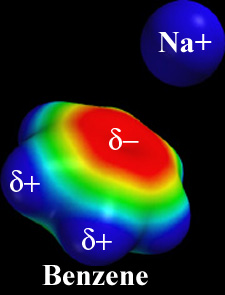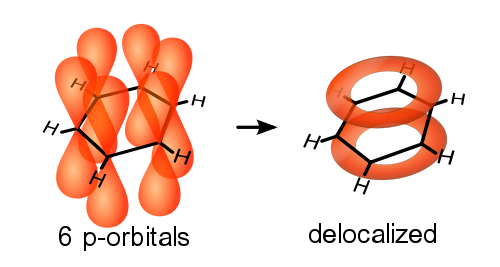Cation-pi interactions: Difference between revisions
Eric Martz (talk | contribs) |
Eric Martz (talk | contribs) |
||
| Line 69: | Line 69: | ||
*Tan XJ, Zhu WL, Cui M, Luo XM, Gu JD, Silman I, Sussman JL, Jiang HL, Ji RY, Chen KX. Noncovalent interaction or chemical bonding between alkaline earth cations and benzene? A quantum chemistry study with MP2 and density-functional theory methods. Chem. Phys. Lett. 2001 349:113-122. [http://www.sciencedirect.com/science?_ob=ArticleURL&_udi=B6TFN-44B4HC9-3&_user=1516330&_rdoc=1&_fmt=&_orig=search&_sort=d&view=c&_acct=C000053443&_version=1&_urlVersion=0&_userid=1516330&md5=aafae3391c122c6fdbfdf1d5c93e76a0 Abstract] | *Tan XJ, Zhu WL, Cui M, Luo XM, Gu JD, Silman I, Sussman JL, Jiang HL, Ji RY, Chen KX. Noncovalent interaction or chemical bonding between alkaline earth cations and benzene? A quantum chemistry study with MP2 and density-functional theory methods. Chem. Phys. Lett. 2001 349:113-122. [http://www.sciencedirect.com/science?_ob=ArticleURL&_udi=B6TFN-44B4HC9-3&_user=1516330&_rdoc=1&_fmt=&_orig=search&_sort=d&view=c&_acct=C000053443&_version=1&_urlVersion=0&_userid=1516330&md5=aafae3391c122c6fdbfdf1d5c93e76a0 Abstract] | ||
*Sussman JL, Silman I. Acetylcholinesterase: structure and use as a model for specific cation-protein interactions. Curr. Opin. Struct. Biol. 1992 2:721-729. [http://www.sciencedirect.com/science?_ob=ArticleURL&_udi=B6VS6-488FR7B-18&_user=10&_handle=V-WA-A-W-WV-MsSAYZW-UUW-U-AACCVECUCE-AACBUDCYCE-WADDYDE-WV-U&_fmt=summary&_coverDate=10%2F31%2F1992&_rdoc=12&_orig=browse&_srch=%23toc%236254%231992%23999979994%23411862!&_cdi=6254&view=c&_acct=C000050221&_version=1&_urlVersion=0&_userid=10&md5=311482e5def4d93a8ddc6423a65772db Abstract] | *Sussman JL, Silman I. Acetylcholinesterase: structure and use as a model for specific cation-protein interactions. Curr. Opin. Struct. Biol. 1992 2:721-729. [http://www.sciencedirect.com/science?_ob=ArticleURL&_udi=B6VS6-488FR7B-18&_user=10&_handle=V-WA-A-W-WV-MsSAYZW-UUW-U-AACCVECUCE-AACBUDCYCE-WADDYDE-WV-U&_fmt=summary&_coverDate=10%2F31%2F1992&_rdoc=12&_orig=browse&_srch=%23toc%236254%231992%23999979994%23411862!&_cdi=6254&view=c&_acct=C000050221&_version=1&_urlVersion=0&_userid=10&md5=311482e5def4d93a8ddc6423a65772db Abstract] | ||
*[http://www.ncbi.nlm.nih.gov/pubmed?term=dougherty%20da%5Bau%5D Search PubMed for ''Dougherty DA'']. | |||
*[http://www.umass.edu/microbio/chime/pe_beta/pe/protexpl/cationpi.htm The Introduction, Gallery & Tutorial for Cation-Pi Interactions from Eric Martz's Protein Explorer] | *[http://www.umass.edu/microbio/chime/pe_beta/pe/protexpl/cationpi.htm The Introduction, Gallery & Tutorial for Cation-Pi Interactions from Eric Martz's Protein Explorer] | ||
*[http://en.wikipedia.org/wiki/Cation-pi_interaction Wikipedia Cation-pi interaction page] | *[http://en.wikipedia.org/wiki/Cation-pi_interaction Wikipedia Cation-pi interaction page] | ||
Revision as of 19:50, 19 June 2011

|
| Cation-pi interaction. Surfaces colored by electrostatic potential. Image adapted from one kindly provided by Dennis Dougherty. |
Cationic moieties, such as sidechain nitrogens (lysine or arginine) or metal cations, that are within 6.0 Å of the face of an aromatic ring (phenylalanine, tyrosine, or tryptophan) may engage in polar interactions called cation-pi interactions (cation-π interactions).
The flat face of an aromatic ring has a partial negative charge due to the pi orbitals. Cationic sidechains (Lys, Arg) or sometimes ligands (including metal ions) often align themselves centered over the faces of aromatic rings. Over one fourth of Trp's in the Protein Data Bank interact with cations, and 99% of significant cation-pi interactions occur within a distance of 6.0 Angstroms [1]. Cation-pi interactions make a significant contribution to the overall stability of most proteins. Gallivan and Dougherty (1999)[1] concluded that "cation-pi interactions should be considered alongside the more conventional hydrogen bonds, salt bridges, and hydrophobic effects in any analysis of protein structure". They can also contribute significantly to intermolecular contacts and interactions with ligands.
- First Glance in Jmol finds and displays potential cation-pi interactions, as described here.
- Protein Explorer (requires CHIME plugin) finds and displays potential cation-pi interactions, as described here.
ChemistryChemistry

Six-carbon aromatic rings occur in the sidechains of 3 of the 20 standard amino acids: namely phenylalanine, tryptophan, and tyrosine. The atomic p orbitals of the carbons overlap sideways, forming a conjugated pi (π) orbital system, or pi cloud of delocalized electrons[2] (see Figure at right). The pi clouds on each face of the ring have a partial negative charge, while the edge of the ring has a compensating partial positive charge (see Figure above). Proximity of a positive charge to one face of the ring induces further polarization, and in the proper conformation produces an electrostatic interaction called a cation-pi interaction.
Occurrence and SignificanceOccurrence and Significance
Gallivan and Dougherty (1999)[1] reported results from a quantitative survey of cation-pi interactions in high-resolution structures in the Protein Data Bank. Using an energy-based criterion for identifying significant sidechain interactions, they studied 593 sequence dissimilar proteins. They found an average of one such interaction per 77 residues, with no significant effect of chain length, or multiple-chain vs. single chain structures. Arg was more likely than Lys to participate in a cation-pi interaction, and the likelihood of aromatic sidechain participation was Trp > Tyr > Phe. Over one quarter of all Trp's were involved in cation-pi interactions, with the cation typically positioned over the 6-atom ring of Trp. Because of the frequencies of amino acids in the database, Arg participates in nearly twice as many cation-pi interactions as does Lys, and the numbers of cation-pi interactions involving Trp, Tyr and Phe are roughly similar. Their study did not include His because, depending on its protonation state, it could participate either as a cation or as a pi-system. Lys and Arg were assumed always to be protonated and hence cationic.
Gallivan and Dougherty conclude "When a cationic sidechain is near an aromatic sidechain, the geometry is biased toward one that would experience a favorable cation-pi interaction", and "cation-pi interactions should be considered alongside the more conventional hydrogen bonds, salt bridges, and hydrophobic effects in any analysis of protein structure". They provide a server that lists text results from their program CaPTURE.
Zacharias and Dougherty (2002)[3] reviewed cation-pi interactions in the binding of ligands to proteins. Cation-pi interactions are usually energetically important when the ligand has either positive charge or an aromatic ring, and are involved in control of ion channels, G-protein-coupled receptors, transporters, and enzymatic catalysis.
ExamplesExamples
| |||||||
Examples from Gallivan and Dougherty[1]Examples from Gallivan and Dougherty[1]
- 1gai: a 472-amino acid chain (glucoamylase) with a spectacular cluster of four aromatic rings (two Trp's, two Tyr's) around a single Lys108 ().
- 1bfg: a 126-amino acid chain (fibroblast growth factor) with an unusually high incidence of cation-pi interactions. Gallivan and Dougherty report 5 energetically significant interactions.
- 2wea: the longest single chain (323 residues) with no energetically significant cation-pi interactions from the original set of 593 proteins originally analyzed.
Example from Zacharias and Dougherty[3]Example from Zacharias and Dougherty[3]
- 1l8b is a portion of a eukaryotic translation initiation factor that recognizes N7-methylated guanosine on the 5'-end of mRNAs. The .
Examples from Eric Martz[4]Examples from Eric Martz[4]
- 1axi (human growth hormone): Chain B contains an unusual string of three aromatic sidechains separated by, and capped at the ends with, 4 cationic sidechains. (Using "c" for cation and "p" for pi, the chain is "cpcpcpc".) Only the one of these six interactions is deemed energetically insignificant by CaPTURE (Lys at one end). See image here.
- 1bl8 (bacterial potassium channel): There is a for each contact between chains of this homotetramer, but no intrachain cation-pi interactions.
- 2vab (peptide bound to class I histocompatibility protein): The N-terminal Phe of the nonapeptide stacks with Trp 167 of the protein. On either side of the stacked rings are cations (Arg 170, Lys 66), forming the unusual cppc chain RWFK. See image here.
- 1rog (peptide bound to class I histocompatibility protein): Three (of the four) cations in the 9-residue peptide interact with aromatic sidechains in the protein groove. This is a theoretical model.
- 1dlh (peptide bound to class II histocompatibility protein): There are no cation-pi interactions for the 13-residue peptide, despite its containing three lysines and one tyrosine. A number of nearby sidechains that potentially could interact appear to be blocked by other noncovalent bonding interactions, and the peptide lysine sidechains are generally pointing away from the protein.
Additional Related structuresAdditional Related structures
- AChE_inhibitors_and_substrates_(Part_II)
- Entries in Proteopedia's Cation-pi Category (with hyphen)
- Entries in Proteopedia's Cation pi Category (no hyphen)
- Entries in Proteopedia's Cation-pi interaction Category
Literature References & NotesLiterature References & Notes
- ↑ 1.0 1.1 1.2 1.3 Gallivan JP, Dougherty DA. Cation-pi interactions in structural biology. Proc Natl Acad Sci U S A. 1999 Aug 17;96(17):9459-64. PMID:10449714
- ↑ Eric Martz thanks Peter Lillya for help with terminology.
- ↑ 3.0 3.1 Zacharias N, Dougherty DA. Cation-pi interactions in ligand recognition and catalysis. Trends Pharmacol Sci. 2002 Jun;23(6):281-7. PMID:12084634
- ↑ These examples were noted in the documentation for Protein Explorer: see Content Attribution for the original documentation.
Additional Literature and ResourcesAdditional Literature and Resources
[xtra 1][xtra 2][xtra 3][xtra 4][xtra 5][xtra 6][xtra 7][xtra 8][xtra 9][xtra 10][xtra 11]
- ↑ Dougherty DA. Cation-pi interactions in chemistry and biology: a new view of benzene, Phe, Tyr, and Trp. Science. 1996 Jan 12;271(5246):163-8. PMID:8539615
- ↑ Beene DL, Brandt GS, Zhong W, Zacharias NM, Lester HA, Dougherty DA. Cation-pi interactions in ligand recognition by serotonergic (5-HT3A) and nicotinic acetylcholine receptors: the anomalous binding properties of nicotine. Biochemistry. 2002 Aug 13;41(32):10262-9. PMID:12162741
- ↑ Gromiha MM, Santhosh C, Ahmad S. Structural analysis of cation-pi interactions in DNA binding proteins. Int J Biol Macromol. 2004 Jun;34(3):203-11. PMID:15225993 doi:http://dx.doi.org/10.1016/j.ijbiomac.2004.04.003
- ↑ Crowley PB, Golovin A. Cation-pi interactions in protein-protein interfaces. Proteins. 2005 May 1;59(2):231-9. PMID:15726638 doi:http://dx.doi.org/10.1002/prot.20417
- ↑ Gromiha MM, Suwa M. Structural analysis of residues involving cation-pi interactions in different folding types of membrane proteins. Int J Biol Macromol. 2005 Mar;35(1-2):55-62. Epub 2005 Jan 28. PMID:15769516 doi:http://dx.doi.org/10.1016/j.ijbiomac.2004.12.001
- ↑ Prajapati RS, Sirajuddin M, Durani V, Sreeramulu S, Varadarajan R. Contribution of cation-pi interactions to protein stability. Biochemistry. 2006 Dec 19;45(50):15000-10. PMID:17154537 doi:http://dx.doi.org/10.1021/bi061275f
- ↑ Crowley PB, Golovin A. Cation-pi interactions in protein-protein interfaces. Proteins. 2005 May 1;59(2):231-9. PMID:15726638 doi:http://dx.doi.org/10.1002/prot.20417
- ↑ Dougherty DA. Cation-pi interactions involving aromatic amino acids. J Nutr. 2007 Jun;137(6 Suppl 1):1504S-1508S; discussion 1516S-1517S. PMID:17513416
- ↑ Wu R, McMahon TB. Investigation of cation-pi interactions in biological systems. J Am Chem Soc. 2008 Sep 24;130(38):12554-5. Epub 2008 Aug 29. PMID:18759391 doi:http://dx.doi.org/10.1021/ja802117s
- ↑ Sussman JL, Harel M, Frolow F, Oefner C, Goldman A, Toker L, Silman I. Atomic structure of acetylcholinesterase from Torpedo californica: a prototypic acetylcholine-binding protein. Science. 1991 Aug 23;253(5022):872-9. PMID:1678899
- ↑ Harel M, Aharoni A, Gaidukov L, Brumshtein B, Khersonsky O, Meged R, Dvir H, Ravelli RB, McCarthy A, Toker L, Silman I, Sussman JL, Tawfik DS. Structure and evolution of the serum paraoxonase family of detoxifying and anti-atherosclerotic enzymes. Nat Struct Mol Biol. 2004 May;11(5):412-9. Epub 2004 Apr 18. PMID:15098021 doi:10.1038/nsmb767
- Felder C, Jiang HL, Zhu WL, Chen, KX, Silman I, Botti, SA, Sussman JL. Quantum/classical mechanical comparison of cation-π interactions between tetramethylammonium and benzene. J. Phys. Chem. 2001 A 105: 1326-1333. Paper.
- Tan XJ, Zhu WL, Cui M, Luo XM, Gu JD, Silman I, Sussman JL, Jiang HL, Ji RY, Chen KX. Noncovalent interaction or chemical bonding between alkaline earth cations and benzene? A quantum chemistry study with MP2 and density-functional theory methods. Chem. Phys. Lett. 2001 349:113-122. Abstract
- Sussman JL, Silman I. Acetylcholinesterase: structure and use as a model for specific cation-protein interactions. Curr. Opin. Struct. Biol. 1992 2:721-729. Abstract
- Search PubMed for Dougherty DA.
- The Introduction, Gallery & Tutorial for Cation-Pi Interactions from Eric Martz's Protein Explorer
- Wikipedia Cation-pi interaction page
Content AttributionContent Attribution
The initial content of this page was adapted, with the permission of Eric Martz, from the Glossary and Introduction, Gallery & Tutorial for Cation-Pi Interactions that accompanies Protein Explorer. Eric Martz is grateful to Peter Lillya for help with chemical terminology and concepts.